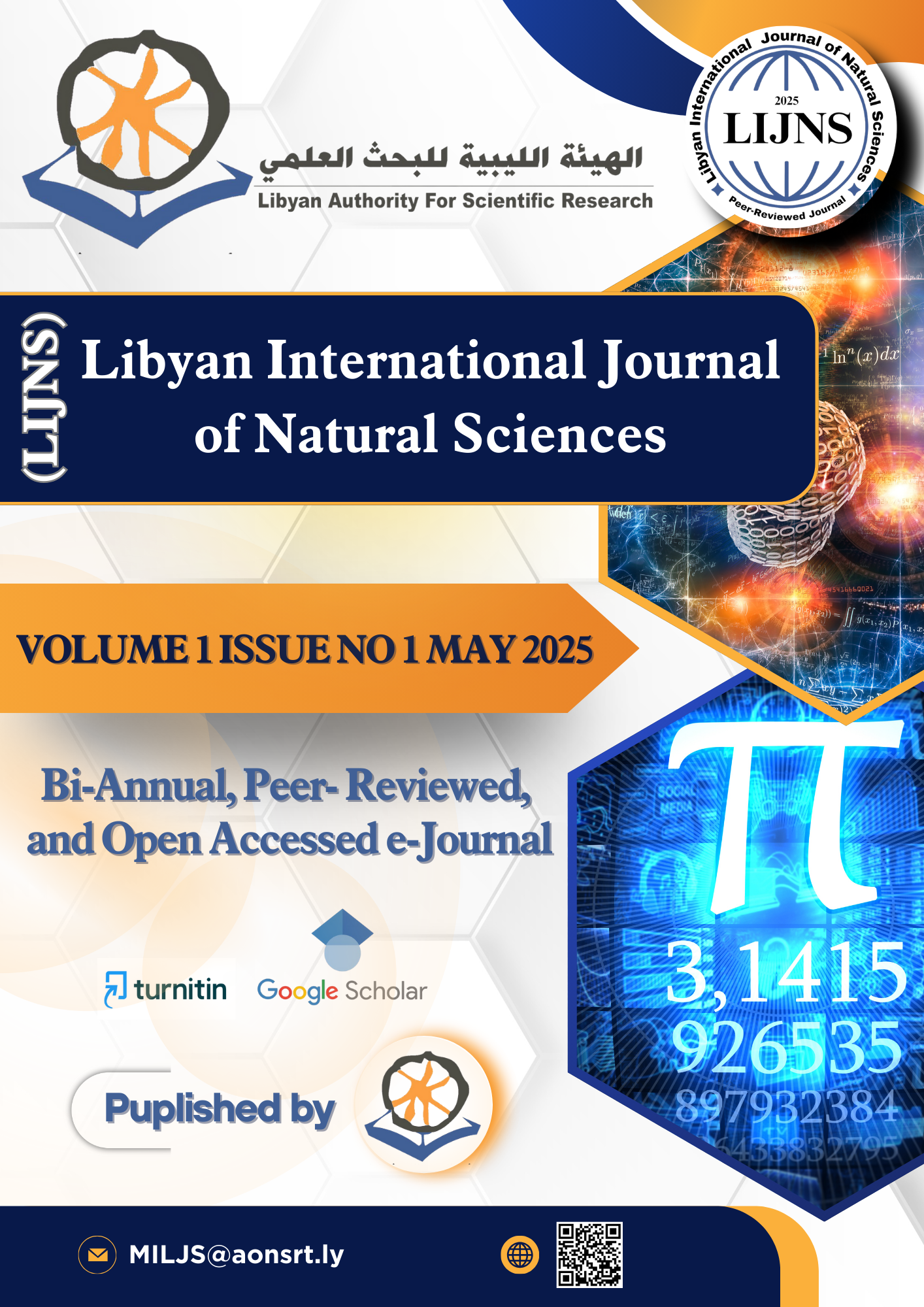Oral Candida Carriage and Fungi Species Prevalence in Libyans
Keywords:
Candida Albicans, Species, Oral Carriage, Antifungal Susceptibility.Abstract
Fungi are normal, harmless commensals found in the mouth of approximately 40% of healthy individuals, however, Candida albicans can be a causative agent for oral fungal infection. Methods: this study comprised 310 routine dental patients, aged 18 years and above, examined in dental clinic over 9 months at Central Dental Clinic in Benghazi city presented with routinely encountered dental complaints such as dental caries, gingivitis, periodontal disease, dental prosthesis problems,.
A mouth rinse was taken from each patient and immediately transferred to the laboratory for cultivation in a Sabouraud’s Dextrose Agar (SDA) by the standard mycological methods. Results: the prevalence of oral carriage of yeasts in 310 cases was 32% (100 patients; 54 females), without any correlation between the clinical variables and candida carriage except for the use dental prostheses. Twelve strains of candidal and non-candidal fungal species could be isolated. Candida albicans in 68 isolates, Candida dubliniensis in 15, Trichosporon spp in 5, candida catenulata in 2, candida krusei in 2, and Candida magnolia, Candida pelliculosa, Cryptococcus humicola complex, Cryptococcus Laurentii, Geotrichum capitatum, and Rhodotorula rubra 1 case each. Interestingly, the isolates were either sensitive (67%) or intermediately sensitive (33%) to fluconazole without a single resistance to it was recorded in this study.
Conclusions: Candida albicans followed by Candida dubliniensis are the most predominate species of the isolated oral fungi, their resistance to antifungal agents is high to amphotericin, fluocytosine, and clotrimazole, but less profound to voriconazole and itraconazole. Interestingly, no resistant strains to fluconazole could be found.
References
[1} A.G. Lourenço, A. Ribeiro, C. Nakao, A.C.F. Motta, L.G.L. Antonio, A.A. Machado et al,. Oral Candida spp carriage and periodontal diseases in HIV-infected patients in Ribeirão Preto, Brazil. Rev Inst Med Trop Sao Paulo. 59:e29. 2017.
[2] S.A. Mokeem, T. Abduljabbar, A.A..Al-Kheraif, M.N. Alasqah, D. Michelogiannakis, L.P. Samaranayake et al, Oral Candida carriage among cigarette- and waterpipe-smokers, and electronic cigarette users. Oral Dis. 25(1):319-26. 2019.
[3] N.A. Alaizari, J.R. Al-Anazi,. Oral Candida carriage in smokers and tobacco users: Asystematic review and meta-analysis of observational studies, J Oral Biosci 62(4):342-8. 2020.
[4] Z. Akram, A.A.Al-Kheraif, S.V. Kellesarian, F. Vohra, F. Javed. Comparison of oral Candida carriage in waterpipe smokers, cigarette
Smokers & non-smokers. J.Oral Sci. 60(1):115-2018. 20.
[5] L. Hu, C. He, C. Zhao, X. Chen, H. Hua , Z. Yan. Characterization of oral candidiasis and the Candida species profile in patients with oral mucosal diseases. Microb Pathog. 134:103575. 2019.
[6] P. Madhavan, F. Jamal, S. Chong PPJJoa. Laboratory isolation and identification of Candida species. 11(16):2870-7. 2011.
[7] Z.A. Kanafani, and J. R. Perfect. "Antimicrobial resistance: resistance to antifungal agents: mechanisms and clinical impact." Clin Infect Dis 46(1): 120-128. 2008.
[8] J. H. Rex, M. A. Pfaller, J. N. Galgiani, M. S. Bartlett, A. Espinel-Ingroff, M. A. Ghannoum et al. Development of interpretive breakpoints for antifungal susceptibility testing: conceptual framework and analysis of in vitro-in vivo correlation data for fluconazole, itraconazole, and candida infections. Subcommittee on Antifungal Susceptibility Testing of the National Committee for Clinical Laboratory Standards. Clin Infect Dis. 24(2):235-47. 1997.
[9] E. Rosa. oral candidosis: physiopathology, decision making, and therapeutics id tu digital 12184. isbn 9783662471944, 2015.
[10] Matti Mauramo, Nurgül Tonoz, Jörg Halter, Betsy Joseph, Tuomas Waltim. Oral Candida carriage and resistance against common antifungal agents in hematopoietic stem cell transplantation recipients. Supportive Care in Cancer 32:185 https://doi.org/10.1007/s00520-024-08396-4, 2024.
[11] T. Rawnuck, Md. Selim Reza, R. Ahmed, Mohammad Fatteh Ul Islam, A. I. Hossain, N. Sultana, S. Monwar. (2022) Prevalence of Oral Candidiasis among Children Caused by Different Candida Species, Medicine Today, DOI:10.3329/medtoday. v34i1.58678
[12] S. H. Al-Amad, B. Rahman, N. Khalifa, M.A. Awad. Oral candidal carriage and its association with dental carious lesions in asymptomatic adults: a cross-sectional study from the UAE. BMC Oral Health. 21(1):197. 2021.
[13] A.N. Ellepola, Z. U. Khan, B. Joseph, R. Chandy, L. Philip. (2011). Prevalence of Candida dubliniensis among oral Candida isolates in patients attending the Kuwait University Dental Clinic. Med Princ Pract. 20(3):271-6. doi: 10.1159/000323440. Epub 2011 Mar 29. PMID: 21454999.
[14] B. J. Kullberg and M. C. Arendrup. (2015) Invasive Candidiasis, N Engl J Med Vol. 373 Issue 15 Pages 1445-56 Accession Number:26444731 DOI: 10.1056/NEJMra1315399 https://www.ncbi.nlm.nih.gov/pubmed/26444731.
[15] M. Mun, T. Yap, A. D. Alnuaimi, G. G. Adams, M. J. McCullough. Oral candidal carriage in asymptomatic patients. Aust Dent J. 61(2):190-5. 2016.
[16] S. Alrayyes, H. Alruwaili, I. Taher, Elrahawy K, Almaeen A, Ashekhi A, et al. Oral Candidal carriage and associated risk indicators among adults in Sakaka, Saudi Arabia. BMC Oral Health. 19. 2019.
[17] Z. A. Krema, E.E.M. Trfas, M.S. Ellabib, M. Cogliati. Oral carriage of candidiasis in patients with oral dental diseases: predisposing factors, species, and their antifungal susceptibility patterns. J Bacteriol Mycol Open Access. 6(3):223‒227. 2018.
[18] R. Pelletier, I. Alarie, R. Lagacé, T.J. Walsh. Emergence of disseminated candidiasis caused by Candida krusei during treatment with caspofungin: Case report and review of literature. Medical Mycology. 43(6):559-64. 2005.
[19] C.R. Cooper. Chapter 2 - Yeasts Pathogenic to Humans. In: Kurtzman CP, Fell JW, Boekhout T, editors. The Yeasts (5th Ed). London: Elsevier; 2011. p. 9-19.
[20] M. Radosavljevic, H. Koenig, V. Letscher, J. Waller, F. Maloisel, B. Lioure et al. Candida catenulata Fungemia in a Cancer Patient. Journal of clinical microbiology. 37:475-7. 1999.
[21] M.V Ha, M.S. Choy, D. Mccoy, N. Fernández, JSJJoCP. Suh, (2018). Therapeutics. Candida catenulata Candidaemia and Possible Endocarditis in a Cirrhotic Patient Successfully Deescalated to Oral Fluconazole. 43:910 - 3.

Downloads
Published
How to Cite
Issue
Section
License
Copyright (c) 2025 Libyan Authority for Scientific Research

This work is licensed under a Creative Commons Attribution-NonCommercial-ShareAlike 4.0 International License.





 Published by:
Published by: 